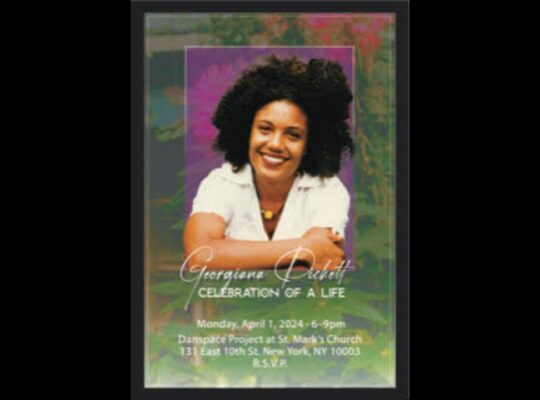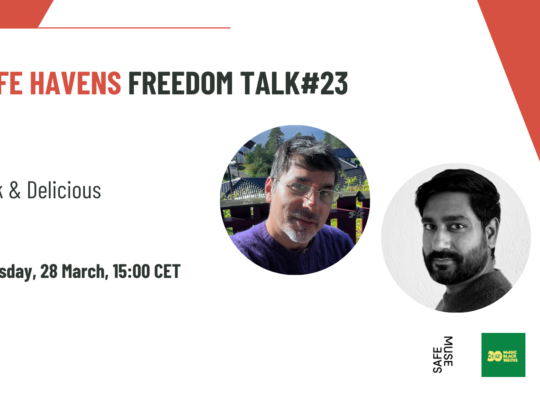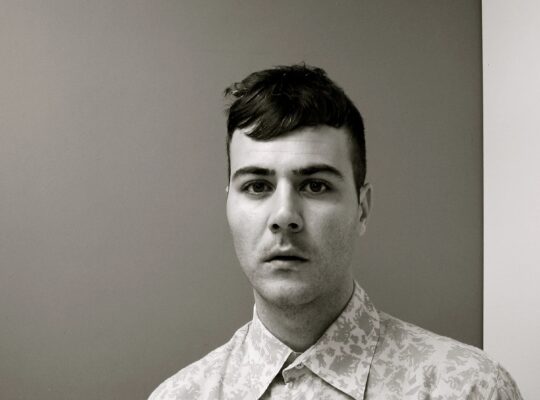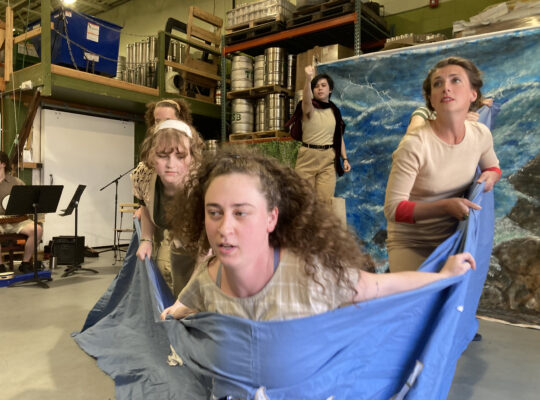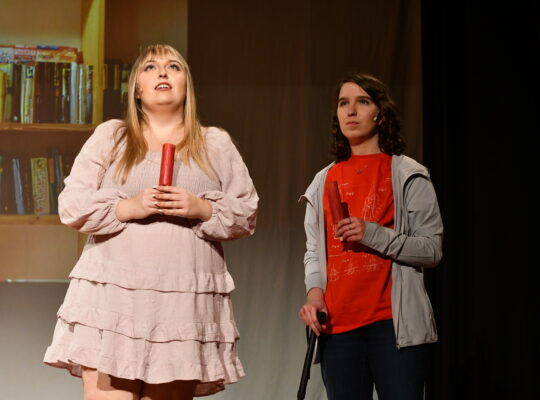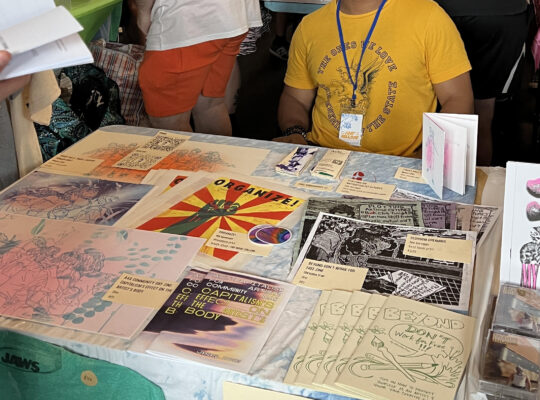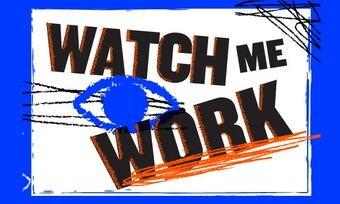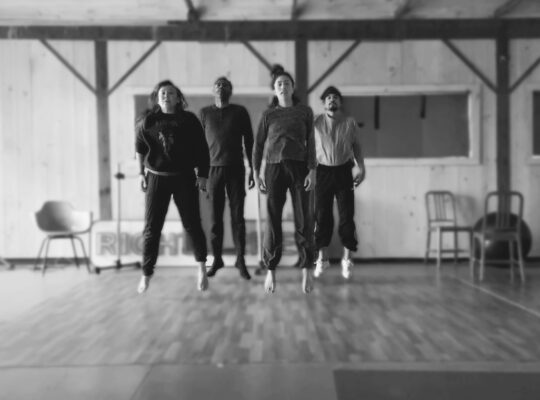LaJuné McMillian: What’s different about this process versus a normal motion capture process is that normally when someone does motion capture in a studio for a project, they’re often met with lists that tell them everything that they’re not supposed to be doing in the suit. So it’s like you can’t roll around on the ground. You really shouldn’t be doing really outrageous jumps or really outrageous spins, mainly because you want the cameras to be able to see all of the dots. If it’s an optical tracking system with infrared sensors, they want to see the dots at various different points. So you have to basically guide the actors in doing that.
I’m using a different type of suit, which has even more rules, and it’s like, okay, don’t do this, don’t do that so that the sensors can see you. But for me, I never said that to my collaborators. I’m like, I don’t really care if it’s perfect. I want to see you. However the technology interprets that is how the technology interprets it. And oftentimes, the suits break midway through the performance, even after we do a calibration, because they’re just doing them.
Tjaša Ferme: Welcome to Theatre Tech Talks: AI, Science, and Biomedia in Theatre, a podcast produced by HowlRound Theatre Commons, a free and open platform for theatremakers worldwide.
LaJuné McMillian is a new media artist and creative technologist creating art that integrates performance, virtual reality, and physical computing to question our current forms of communication. McMillian is passionate about discovering, learning, manifesting, and stewarding spaces for liberated Black realities and the Black imagination.
Your work in general is this very unique intersection of performance, of new technologies, of archiving, of education. So can you tell us a little bit more about what was your path? How did you get here?
LaJuné: Yeah. I guess I’ll start from my time in college. I went to NYU. I was part of what was then called the Integrated Digital Media Program. And before I transferred to that program, I originally went to school for mechanical engineering. And so I thought that I was going to have this career as an engineer, but then I realized very early on that that just was not going to be the vibe for me, mainly because I was having difficulty in my classes, but also not just with the coursework itself, but also with my peers and my community. And so I was just like, oh my gosh, this is going to be it. These are my peers and this is who I’m going to be working with, and so this is just not going to work out for me. So yeah, I switched my major to digital media. I didn’t know what it was. I didn’t know that you could make art with technology. That was never something that I even considered. And so it was a very happy accident.
Tjaša: Can I actually stop you here? I’m actually super interested. What is digital art? I feel like it’s such a blanket statement. I mean, everybody kind of pretends they know what it is, but I don’t think that we really all know what it is or all facets of what it is.
LaJuné: Yeah. I think, I guess there are two ways to answer the question. For me, being an artist in general, taking the technology out of it, I think my role and what my job is, is to basically take a witnessing role to the world around me, to my community, to my collaborators, and I guess make content about that. What does it mean to go through life and storytell and record those stories and hold those stories and then retell those stories? And when I place technology back into that equation, I’m really talking about, or I’m thinking about, how to do those retellings with various different mediums through various different mediums of various different tools.
I like to work with different technologies. I create video art, but then I’m also making virtual reality. I’m also making live motion capture performance art. And the stories themselves, they morph and change, but I’m trying to always figure out what points or portions of those stories stay true throughout. I do like to work with mediums in a way where I’m never trying to just make a story one-to-one. The video art never has to be completely the same as the virtual reality product because they’re two different mediums and they have two different ways of being experienced and being seen. And so, I think, for me, I just like to work with that and morph with that. And then it becomes this wider conversation about my relationship and my community’s relationship to these tools and to these technologies.
What does it mean to then question those power dynamics—how much power we give the digital tools that we’re using…? And what does it mean to restructure those power dynamics so that we as users of these tools are not just extracted from, but are contributed to?
And so, yes, it does become a conversation around using tools and softwares that are sometimes used for surveillance and for very harmful outcomes. How do you hack those digital tools and different digital technologies and make them not do that? And so, yeah, I think that in that way I’m also questioning the softwares, pushing them, breaking them, and then telling stories with them. And then I’m basically asking how stories and how our stories, whether it be through oral storytelling, through spoken word, or through movement, or through our bodies, how does that rupture or hack the tools that we’re using?
And so I guess that’s what my job is as a new media artist. But I guess with technology, there’s so many different tools. I think one of the things I’m also always talking about is even just the term technology, I think a lot of people reserve that term for digital technologies, but there are various different technologies that are analog, that are not having to do anything with the digital. So what does it mean to then question those power dynamics? How much power we give the digital tools that we’re using versus the other tools that we use? And what does it mean to restructure those power dynamics so that we as users of these tools are not just extracted from, but are contributed to and from?
Yes, we’re using these tools every day, but I do also have an understanding that there will be new tools that will need to be built that have ethics already built in from the onset. And so, what does it mean to then create those system of values before things are even made? So it’s questioning a lot of the tools and softwares. It’s saying, okay, we can use these for our projects, but it’s not necessarily dependent on them or saying, this is it. This is just going to be what it is. But I also know that I’m one person, so I can’t necessarily build software and tools and make art and build community and do all these things.
So basically, I’ve been focusing on what does it mean to be in community with people, especially because for me, I grew up an only child, so I never really grew up… I grew up with my mom, my stepdad, but I never really, I guess, had intrinsically the ideals around what it means to be in community and what it means to truly and fully see someone else. And so it’s been a lot of a learning curve for me too, mainly because, what is accountability and how do I hold myself accountable to my community that I’m building? And how do I grow and morph as an artist? And what does it mean to build out and carve out space for all of us to do that same thing? So now that we’re working with these tools and technologies, we’re questioning them and we’re saying, okay, what is implicit within this tool and software that reinforces the idea that I am not enough and that my body isn’t worthy? And then, how do I then counter that and say no? Even though this is saying that I know that that’s not real. And in the future, we need to begin to build technologies that already infuse our humanity within them.
So that’s pretty much where my standpoint is rather than just focusing solely on what other people and other systems are doing.
Tjaša: Super interesting. I love the intertwining of your own personal story because it really explains the journey. I find it really interesting that you said that you needed to learn how to see other people and how to be in community. And so it’d be interesting to hear more about how the technology was helpful or not helpful in this way.
LaJuné: Yeah. I guess going back to my time in school, essentially when I started working with a lot of these tools, it was a very weird process. I had gone through a lot of just breakdowns because I guess school and all of these things are happening at once, and you’re being forced to grow up and be an adult, but also you’re given these tools and these softwares and they’re being thrown at you in every class and you’re being told to just make something with it. And what I realized was I was making stuff, but I was also taking in… It also wasn’t helpful in the fact that I didn’t really have language for what was actually happening when I was learning these tools and I was making stuff.
And so as I got a bit older and I began to find language, and I began to see, oh my gosh, this tool thinks that all Black people look a certain way or all Asian people look a certain way or that we should be able to just drive people as avatars instead of just allowing them to be human and to tell their own stories, I didn’t realize that all of these ways that we were interacting and all of these systems that we live in through our daily lives were being just reestablished within the softwares that I was using. And so it very much contributed to a lot of my, I would say, current mental health issues.
And also, it was a very lonely experience in that there wasn’t many Black people in my cohort. So it was having to do a lot of these things oftentimes by yourself or with just one other person and not having anybody else to back you up and say, “Oh, I hear you. I understand this is happening.” And to have that language for you, that’s a very traumatizing thing because you’re going through all of these terrible, consistent experiences and not really knowing what to do about it.
And so I actually ended up not even graduating from my program due to financial aid issues, but what that experience taught me was that… Right after that, I ended up directing a skating program and doing all these other stuff and reestablishing that. But then, what I realized was that it wasn’t necessarily academia’s approval of me that I needed. It was my voice that I needed, and that was most important. And so when I began to speak more, people started to listen, and then people started to get interested in what it is I was saying.
Then, around that time, I came up with the first iteration of the Black Movement Project, and it was just a database of motion capture data from Black folks. But then I realized that that would actually just contribute to the same paradigms that I didn’t necessarily want to be a part of, mainly because it didn’t address the erasure, the extraction, the exploitation of our movements in our bodies that have existed since America’s inception. So what would it look like to begin to think about what a space, an archive, a library, what would that look like? How would you interact with it? How would you make with tools that that space has? Those were questions I began to start asking because I just feel like we can no longer really afford to continue to think about our data in just quantified ways. None of us are just numbers, and so to treat our movements in our bodies and all of the different types of information about us as just data sets, I just think that that’s very harmful to us.
Tjaša: Yeah. In your Black Movement Library, I feel like the portraits of artists are extremely individualized. They’re extremely, from a personal point of view. And what they seem to be saying is that they found some confidence and liberty within this process of expressing themselves and dancing and working with you and using these technologies as much as they’ve seen mostly motion captures and motion sensors. What do you think how the technology played a role in them finding the liberty and finding ways to express themselves better?
LaJuné: Yeah. Basically, how I came up with the idea for movement portraits, it was this question of looking at various different motion capture databases and only being met with lists of movement and sometimes not even being met with the name of the actor who made the movements, not being given any other information about those movements. So I was questioning what it means to hold and celebrate various different types of data at the same time. I think that, yes, you can have a movement library. There are various different ways that people move, and you can see that through various different genres of dance. However, when an individual comes and does that movement, they’re bringing their full selves to that movement too. So it’s important to not only pay homage to the movement, but also to the person who’s able to do that movement.
And so with the movement portraits, I decided that I was going to begin to really dive into the stories of the people that I’m working with, my collaborators. And so I do these documentaries with them, and I do these interviews with them, and I ask them about their movement journeys and their movement practices and their movement histories. And then I ask them about their favorite colors, and we start from that as a base. And then I create their avatars, and then they put on the motion capture suit.
And what’s different about this process versus a normal motion capture process is that normally, when someone does motion capture in a studio for a project, they’re often met with lists that tell them everything that they’re not supposed to be doing in the suit. So it’s like you can’t roll around on the ground. You really shouldn’t be doing really outrageous jumps or really outrageous spins, mainly because you want the cameras to be able to see all of the dots. If it’s an optical tracking system with infrared sensors, they want to see the dots at various different points. So you have to basically guide the actors in doing that.
I’m using a different type of suit, which has even more rules, and it’s like, okay, don’t do this, don’t do that so that the census can see you. But for me, I never said that to my collaborators. I’m like, I don’t really care if it’s perfect. I want to see you. However, the technology interprets that is how the technology interprets it. And oftentimes the suits break midway through the performance even after we do a calibration because they’re just doing them. So it’s very much just a… I try my best to build a liberatory process in how I am witnessing them through a lot of these different tools and technologies.
Tjaša: I love it. So you’re asking them to bring their full person and the full artist to what they’re doing. You’re basically saying that technology oftentimes needs working in gloves, dainty. It’s almost this, a laboratory environment where you have to be a purified or stilted version of yourself, and you’re rejecting that paradigm and you’re saying, no, let technology do what it does, but I want you to be a full-fledged human and artist that you are.
LaJuné: Absolutely.
Tjaša: I love that. I love that. And basically, while doing this, you’re also the documentary filmmaker for this project and for the ice skaters as well, which all of that is a huge job to be your own technologist and also the filmmaker of the process.
LaJuné: Yeah. And I do work with one of my really good collaborators and friends, Emmanuel Montegon. And basically, he helps me with a lot of the filming process.
Tjaša: Good. It’s always good to have a team. Yeah, yeah, yeah. What’s the background of ice skating, when you were just saying that?
LaJuné: Yeah. I grew up figure skating. When I was around nine, is when I started to pursue it a little bit more seriously. But when I was younger, I used to watch it a lot with my great-grandmother on TV. And right now, I’m actually working on a new media live motion capture performance project on ice about the history of Black figure skaters because my great-great uncle, which is her brother, he taught himself how to figure skate out of various different rinks in New York City. And so skating has been in my family. I’ve had cousins who’ve grown up skating. So I guess it was just natural for me to be interested in doing it, even though my parents never necessarily tried to convince me. I was the one who was doing most of the convincing on my part. And so, yeah, I had my ninth birthday at the ice rink, and then I just started taking lessons from there.
And I think, as the years went on, I mean, I just fell in love with it. I think skating was absolutely my first love, but I don’t think that my parents had necessarily the resources to be able to provide me with the extent of training that I needed. I got good training, and my parents did all that they could, but I was skating with girls who were homeschooled, and literally their ice rink was their life, and I wasn’t getting homeschooled or anything like that. So yeah, it’s definitely a different world. After high school… Well, actually, midway through high school, my mom was just like, “Listen, you got to just start focusing on school.” So I quit and it broke my heart. But what I’ve learned, I guess, now is that I can, and that I always will have a relationship to the sport. It just grows and morphs and changes.
I’m really excited to be working on this ice show, though. I’ve been working with Ice Theatre of New York. We did the first iteration last December, actually around this time. And now I’m actually in the process of starting interviews again. So I’ll be doing interviews with actually some of my great-great uncle’s peers, their families. So yeah, that’s pretty much with skating.
Tjaša: Yeah, yeah, yeah. And where has Black Movement Library been screened, and what were the responses that you have gotten about people experiencing it and moving through some stuff through it, with it?
LaJuné: Yeah. Basically, it’s had a few different iterations. It actually started with just two folks, Ronaldo and Nala, who actually were in the second iteration, but we started in Barbarian Group. Barbarian Group is this creative agency in Manhattan. And so they gave us an art residency there, and we did the initial movement portraits there. And we actually did a performance there too, which was really funny because it was in the middle of their office space, but it was really cool. And so that was where the initial performance happened.
And then, two years later, in 2021, we did a larger scale version at the Brooklyn Public Library. So I was able to bring on more dancers that I was in community with. And it was really amazing. We were there for two nights. I was able to… Basically, I use their motion capture data, but it gets sent to me into Unreal Engine, which is the visual gaming software that I use to create all the visuals, but it allows me to be able to do it in real time. So as the performers are dancing, I’m able to, live, change the elements on their avatars.
So then we did that. And then, one year later, in 2022, I translated the performance into a virtual reality experience that premiered at Tribeca Film Festival and then went to London Film Festival. And then, from there, it also showed as a Times Square midnight moment around the same time that it premiered at Tribeca. And then, after that, we did the first iteration of a pop-up library experience in September. And so, basically, I organized a collection of books around the subjects around race and technology, race and movement, but also Black political movements. So trying to make this intersection of these three different fields into one space, and to be in conversation with one another, alongside with computers that people could use as well as access to the actual tools.
And then I also hosted a Black movement and digital spaces like mini conference. And so it was just two days of journaling, movement, embodiment work, as well as intro to technology, all of these tools that are being used, and also this integration of conversations as well. So I got to speak with other Black library owners, and we got to talk about the future of Black libraries, but then I also got to speak with other Black technologists, and we got to really talk about what it means to learn in this field. So what I’m really interested in is really trying my best to insert technology, digital technology into these fields that really need it and really need to embed it within their conversations and spaces.
Tjaša: What is it that white people don’t know about Blackness and technology?
LaJuné: I mean, I think I would say that… I mean, for me, going through life, you look at things as a scale of harm or how much harm is caused. And if it’s not that much harm being caused to me, then why should I care? I feel like there are probably people out there who are feeling that way. It’s like, I already have all these other things. This isn’t harming me that much, then I should just leave it alone and not bother with it. But it’s like, no, actually, what if we looked at a lot of these different harms in a more holistic way and said, hey, actually, all of these harms are connected. They’re all intertwined, all connected. And if we approached it with an entire community shift in how we’re relating with each other and with ourselves and with our families and with our communities, then we could really get a lot of work done.
I think that a lot of what I’ve seen also over the years is using technology as the sole scapegoat to a lot of the issues. So a lot of people are blaming artificial intelligence, blaming machine learning, blaming this, blaming that, and it’s like, no, we actually need to deal with these foundational issues of racism, sexism, fatphobia, all of these isms. We need to deal with that. And then, from there, we can begin to build tools and technologies that better reflect how our community values life in our humanity.
I think, so oftentimes people try to put the… Is it called the horse before the cart? Yeah. They try to put the horse before the cart and they’re like, “Oh, I can just build a tool that will fix this.” And it’s like, no, you can’t just build a tool that will fix this. You need to actually do and commit to the inner work that is necessary.
Tjaša: I know. It’s so complicated. It’s so funny. We live in this quick gratification society or where you think that just by building another Super Mario game, you will be able to address the world’s problems. And it’s like you are creating more problems presented as solutions in virtual and simulated realities, but it doesn’t actually address what’s happening right here in this physical reality.
How do you use AI in your work, if you do, and what are your general views on AI?
LaJuné: Yeah. I don’t necessarily use machine learning in my work right now. I do have some projects that I’m interested in creating though. And I think that it really starts with, or at least from my understanding of machine learning, it really starts with the care of the data that you’re collecting. For instance, there is a database that is involved with a lot of these movements that I’ve been recording over the years, but I’ve said that I’ve been creating movement portraits and various different other artworks with the movements and not necessarily using it to compare itself with the other data to derive some new work.
So I haven’t done anything like that with it yet. And I didn’t start with that because I just needed to really do a deep dive and understand the data that I already had and just be like, okay, what is this? How do I work with this in an ethical way? And now, from there, I’m thinking about, okay, how can I begin to build what I’m calling different types of consciousness? Mainly because I feel like a lot of our ideas and a lot of our movements are very similar in various different ways. And so what would it mean to collect and honor those various different movements and ideas into one place and be able to hear some of those different ideas and maybe even come up with new ideas? That’s how I would use it. I am working on a new project though now that will be more about that, but yeah.
Tjaša: I mean, plug it in. Tell us what you can. Tell us what you can reveal about it.
LaJuné: Yeah. I’ve been working on a… It started off as a one person performance, and it’s called Spirit to Child. And so, essentially, I’ve been developing different series of prayers, just writing them down, and they’re all about prayers for this moment, prayers for my inner child, prayers for me now, and then prayers for my community and my world. And so, in the performance… It’s a live motion capture performance. So I’m wearing the motion capture suit. And I develop these worlds based off of that, very similar to the other work that I do, but I move through each world and I bring the audience with me and I recite the prayers, so there’s a prayer for each world. And then I wrote them all down on dissolvable paper that I then do this water ritual with. And so I send the prayers to spirit, and then I asked the audience to send with me their prayers to spirit as well. And so I began to think about this idea of, I have my prayers, the audience has their prayers, but what if I could also collaborate with other artists and try to understand what their prayers are?
I actually just came back from Jacob’s Pillow. I was there for ten days, and we did a first iteration of a collaborative form of that. And so the first four days we did some journaling around prayers for a Black liberated reality. So what is a Black liberated reality? And we each responded to that prompt, and then we recited the prompts as we were moving through the space. And that also, well, it had motion capture in the worlds available. And for me, a lot of my worlds and my process and how I think about live motion capture performance is that I think of it as this interaction with the portal. And so all of these portals to Black liberated realities, and so all of these performances or what it means to interact with, to step into, to be in that Black liberated space.
So I’m really interested in creating a machine learning project where I collect all of the prayers, and I then allow the consciousness to reread the prayers, but then also to remix them and to develop new prayers. And so I’m really excited about that.
Tjaša: Did you just call basically an AI program or machine learning “consciousness”?
LaJuné: Yeah.
Tjaša: I love that.
LaJuné: A collective consciousness, yeah.
Black liberated realities exist now, and I know that they exist because I feel like I can tap into them, especially when I’m with and working with my collaborators.
Tjaša: Yeah, yeah. What is a Black liberated reality for you?
LaJuné: Well, one thing I normally always say is that Black liberated realities exist now, and I know that they exist because I feel like I can tap into them, especially when I’m with and working with my collaborators. It’s embedded within moments of time. They’re not always super long and drawn out, but it’s a moment in space where you feel seen, you feel heard, and you feel this overwhelming love and care. And that’s really hard to come by because I feel like I move normally through the world, through life, having to have a shield over me all the time, having to overly be protective and not connect and not be vulnerable because you have to protect yourself. Because if you don’t do that, you could die being that open. But on the flip side, to have a space carved out to be able to convene in that way, I think that that’s a Black liberated reality to me.
Tjaša: I love it. This was so beautiful. I hope that these prayers come true and that you find more of these spaces and more of these moments. Thank you so much. This was amazing. There was something so human and vulnerable and soul soothing. Thank you so much for sharing so much about yourself and your journey and the work that you are making, that’s super important. And I feel like you are a voice of a generation just from your experience, from everything that you’ve been through and what you’re feeling and expressing.
LaJuné: Thank you so, so much. I mean, I’m just trying to vibe. And I don’t know. I really don’t know how… I feel like I just fell into this, and I’ve just been riding the wave ever since, but it’s been worth it, and I’m really just happy and grateful that I can be here to tell the story.
Tjaša: This podcast is produced as a contribution to HowlRound Theatre Commons. You can find more episodes of this show and other HowlRound shows wherever you find podcasts. If you love this podcast, I sure hope you did, post a rating and write a review on those platforms. This helps other people find us. If you’re looking for more progressive and disruptive content, visit howlround.com.



